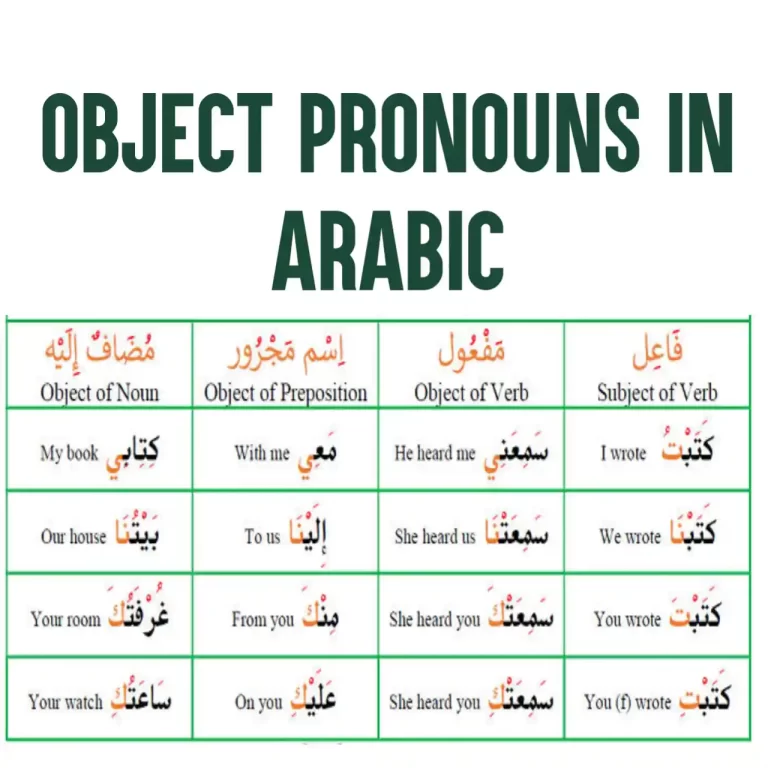Nominative Case Arabic Signs And Examples
Advertisements
One distinctive feature of the Arabic language is its use of cases, which are grammatical forms that indicate the role of a noun or pronoun in a sentence.
Nominative is one of the three Arabic cases. In this lesson, we are going to study the nominative case Arabic, signs endings and examples.
What Is Nominative Case Arabic?
The nominative case in Arabic, also known as the al-marfu (مَرْفُوعٌ) case, is used to marks the subject of a sentence. It is the default case in Arabic. They are marked by a Dammah ضمة (or an equivalent) on the ending letter(s).
Adjectives that modify these nouns are in the same case and have the same Harakah. If there is nothing that affects a word to be in accusative or genitive, the word has nominative case.
Nominative Case in Arabic is characterized by dhumma, the vowel u. Indefinite words in nominative case often end in double dhummas, pronounced as un ٌ and is written as two loops above the final letter of the word.
Advertisements
Definite words with nominative case often end in dhamma and pronounced as u which is written as a loop above the final letter of the word.
In Arabic, nouns and adjectives are inflected to reflect their grammatical role in the sentence.
There are six nominatives (Al-Marfou’at):
The Nominal Subject
The nominal subject, known as Al-Mubtada’ المبتدأ is usually the noun that starts the nominal sentence.
It is always in the nominative case and has a Dammah or equivalent on its ending. It has different types.
Advertisements
Examples
- The lion is an animal = الأسدُ حيوانٌ
- Health is a blessing = الصحةُ نعمةٌ
The Nominal Predicate
The nominal predicate is called Al-Khabar الخبر in Arabic. It is usually the noun or the other part of the sentence that completes the meaning in the nominal sentence. It follows the nominal subject or can sometimes be a fronted predicate.
Examples
- The book is a friend = الكتابُ صديقٌ
- Victory is near = النصرُ قريبٌ
The Noun of Kana and Sisters
The incomplete verb Kana كانَ and its sisters verbs can come in the front of the nominal sentence. They change the nominal subject into the subject of them. This noun is always in the nominative case.
Examples
- The weather was beautiful yesterday كان الجوُ جميلاً بالأمس
The Predicate of Inna and Sisters
Inna and sisters also come with the nominative sentence but they change the Harakah of the subject.
However, the harakah of the predicate remains the same (Dammah). That is to say that the predicate of Inna and sisters is in the nominative case.
Examples
- The man is hungry = إنَّ الرَّجلَ جائعٌ
- The plane is fast = إنَّ الطائرةَ سريعةٌ
The Verbal Subject
The verbal subject is known as al-faa’il الفاعل in Arabic. The subject of the verbal sentence is in the nominative case, so it has a Dammah (or an equivalent) on its ending.
- The flowers bloomed = تفتَّحَ الزَّهرُ
- The branch broke = اِنكسرَ الغصنُ
- Muhammad Wrote the lesson = كتبَ محمدٌ الدَّرسَ
The Deputy Agent (Passive Subject)
The deputy agent is called naa’ib al-faa’il نائب الفاعل in Arabic. The passive sentence is a type of verbal sentence as it starts with a verb.
Now, the deputy agent in the passive sentence is always in the nominative case and has a Dammah (or an equivalent) on its ending.
Examples
- The lesson was written = كـُتبَ الــدَّرْسُ (Passive Voice).

Signs of Nominative Case in Arabic
As was mentioned earlier, the nominative case is the case of nouns used as subject and predicate of the nominal sentence as well as subject of verbal sentences, and their modifying adjectives.
In Arabic, the nominative case is indicated by certain vowel patterns, or diacritics, that are added to the end of the noun.
Plural nouns have different diacritics for the nominative case, depending on whether they are masculine or feminine and whether they are indefinite or definite.
There are various endings used to mark the nominative case; depending on the number, gender and definiteness of the noun or adjective in question.
Dhamma
Damma is the common sign of nominative in Arabic. Definite singular (and broken plural) nouns and adjectives are marked by (ضمة) which is written as (ـُ), and sounds like a short /o/.
Examples
- The boy wrote the homework = كتب الولدُ الواجب
- The student studies at university = الطالبُ يدرس في الجامعة
- The bridge = اَلجِسرُ
- The bridges = اَلجُسُورُ
- The photographers (feminine) = اَلمُصَوِّرَاتُ
Indefinite singular (and broken plural) nouns and adjectives are marked by double dhammas which is written as (ـٌ) and has the sound /un/.
Examples
- A bridge = جِسرٌ
- Bridges = جُسُورٌ
- Photographers = مُصَوِّرَاتٌ
- He is a new student = هو طالبٌ جديدٌ
- A girl came to the party = جاءت بنتٌ إلى الحفل
Alif
Alif is the sign of nominative in dual nouns. In Arabic, dual nouns and adjectives are marked by the suffix (ان). Examples
- Two photographers (masculine) = مُصَوِّرَانِ
- The two photographers (masculine) = اَلمُصَوِّرَانِ
- Two photographers (feminine) = مُصَوِّرَتَانِ
- The two photographers (feminine) = اَلمُصَوِّرَتَانِ
- They are new students (2 male students) = هما طالبان جديدان
- Two girls came to the party = جاءت بنتان إلى الحفل
Waw
Waw is the sign of nominative for ound masculine plural nouns and adjectives are marked by the suffix (ون).
Examples
- They are Saudi engineers = هم مهندسون سعوديون
- The photographers (male) = اَلمُصَوِّرُونَ
Conclusion
In summary, the nominative case in Arabic is the default case. It is used if the word is subject in a verbal sentence, subject in a nominal sentence or predicative in a nominal sentence, kaana’s subject (ismu kaana) or the subject of any of kaana’s sister verbs, inna’s predicative (khabaru ‘inna) or the predicative of any of ‘inna’s sister particles.
It is an important case to understand in Arabic grammar, as it helps to clarify the relationships between nouns and verbs in a sentence.
Advertisements







